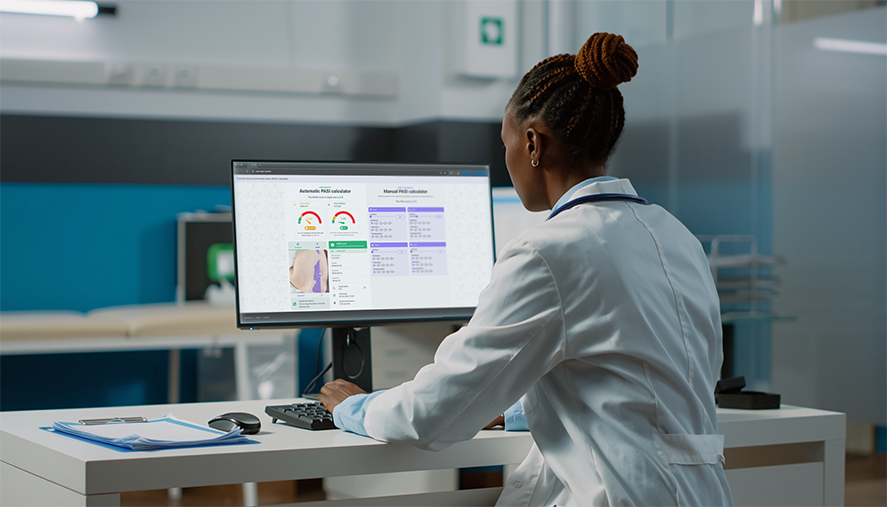APASI: El futuro brillante de la evaluación de la gravedad de la psoriasis ha llegado
Introducción
Legit.Health presenta un avance revolucionario en la tecnología de evaluación dermatológica: el sistema APASI (Índice Automático de Área y Gravedad de la Psoriasis). Esta solución innovadora aprovecha el poder de la inteligencia artificial para analizar imágenes clínicas y calcular automáticamente las puntuaciones PASI estandarizadas, transformando la forma en que se evalúa la gravedad de la psoriasis en la práctica clínica y la investigación.
Utilizando algoritmos de visión por computadora, nuestros investigadores han creado una herramienta que procesa imágenes de teléfonos inteligentes y las traduce automáticamente al dominio del PASI, proporcionando evaluaciones objetivas, rápidas y precisas que complementan los métodos de evaluación clínica tradicionales.
El desarrollo y validación de APASI han sido documentados en una publicación científica completa en JEADV Clinical Practice:
APASI proporciona un marco robusto impulsado por IA para la evaluación de la gravedad de la psoriasis, ofreciendo evaluaciones rápidas, objetivas y precisas. Su integración en los flujos de trabajo clínicos y de investigación podría mejorar el seguimiento de la enfermedad, mejorar la evaluación del tratamiento y reducir los costos de evaluación.
Te animamos a leer la publicación completa.
Mac Carthy T, Dagnino D, Medela A, Fernández G, Aguilar A, Martorell A, Gómez-Tejerina P, Roustán-Gullón G. Artificial Intelligence-Based Quantification to Assess the Automatic Psoriasis Area and Severity Index. JEADV Clin Pract. 2025. https://doi.org/10.1002/jvc2.70143
Comprendiendo el desafío en la evaluación de la psoriasis
La psoriasis afecta aproximadamente a 125 millones de personas en todo el mundo, manifestándose como placas eritematosas con escamas plateadas que impactan significativamente la calidad de vida de los pacientes. A pesar de la visibilidad clínica de las lesiones de psoriasis, lograr evaluaciones de gravedad consistentes y objetivas sigue siendo un desafío.
Los orígenes y limitaciones del PASI
El Índice de Área y Gravedad de la Psoriasis (PASI) fue publicado por primera vez en 1978 por T. Fredericksson y U. Pettersson. Su fórmula para evaluar la gravedad de la afección se convertiría en el estándar de oro para los dermatólogos de todo el mundo y todavía se usa ampliamente en la actualidad.
Sin embargo, la evaluación tradicional del PASI presenta varias limitaciones críticas.
Encontramos una variación sustancial [en los resultados] entre médicos experimentados e inexpertos que usan PASI
En otras palabras, existe una alta variabilidad inter-observador, que es más pronunciada cuando se compara entre profesionales experimentados e inexpertos.
Aparte de la variación inter-observador, muchos médicos han informado que completar la hoja de papel es demasiado tedioso y consume mucho tiempo y que realmente no la usan en el día a día. Esto ha llevado a la subutilización del PASI en la práctica clínica, a pesar de su reconocida importancia en el manejo de la psoriasis.
Hoja de puntuación PASI del Ministerio de Salud de Columbia Británica
Calculadoras digitales: Una solución a medias
Con la llegada de la computación básica, se desarrollaron varias versiones digitalizadas del sistema de puntuación PASI en un intento de reducir el tiempo perdido en cálculos. Estas calculadoras en línea abordan, aunque de manera ineficiente, solo uno de los problemas que tiene el PASI tradicional. Si bien la fórmula se calcula automáticamente, el médico aún tiene que completar el valor de cada parámetro.
Esto no solo requiere el tiempo y la atención del médico, sino que no hace nada para abordar los múltiples problemas de falta de objetividad y reproducibilidad dentro del sistema PASI.
¿Cómo sabemos si un sistema de puntuación es bueno?
Cuando se trata de evaluaciones dermatológicas, la efectividad de un sistema de puntuación es primordial. Pero, ¿qué es exactamente lo que hace que un sistema de puntuación sea fiable y útil? A través del consenso científico, se han identificado varios factores clave que contribuyen a la robustez de estas escalas. Vamos a profundizar en los elementos cruciales:
- Facilidad de uso: Este factor considera si el sistema puede aplicarse sin esfuerzo dentro de las limitaciones de tiempo y recursos financieros. Que un sistema sea fácil de usar es crucial para su adopción generalizada en entornos clínicos.
- Sensibilidad al cambio: Un sistema de puntuación efectivo debe ser capaz de detectar cambios clínicamente significativos a lo largo del tiempo. Esta sensibilidad asegura que cualquier progreso o deterioro en la condición de un paciente se captura con precisión.
- Fiabilidad interobservador: Esto se refiere a la consistencia de los resultados cuando diferentes observadores utilizan el sistema de puntuación. Una alta fiabilidad interobservador significa que diferentes dermatólogos llegarán a conclusiones similares, mejorando la credibilidad del sistema.
- Variabilidad intraobservador: Esto analiza la consistencia de los resultados cuando el mismo observador utiliza el sistema de puntuación varias veces. Una baja variabilidad intraobservador indica que el sistema proporciona resultados similares todas las veces que un mismo dermatólogo evalúe un mismo caso.
- Interpretabilidad: Un sistema de puntuación práctico debería proporcionar interpretaciones cualitativas significativas de sus puntuaciones, como categorizar la gravedad de una condición como leve, moderada o severa.
Estos criterios no solo aseguran la efectividad del sistema de puntuación sino también su aplicabilidad y fiabilidad en diversos escenarios clínicos.
Adaptado de "Methods and definitions to rate the quality of outcome measures". Schmitt, J., Langan, S., Deckert, S., Svensson, A., von Kobyletzki, L., Thomas, K., & Spuls, P. (2013). Assessment of clinical signs of atopic dermatitis: A systematic review and recommendation. Journal of Allergy and Clinical Immunology, 132(6), 1337--1347. doi:10.1016/j.jaci.2013.07.008.
La solución APASI: Evaluación de psoriasis revolucionaria impulsada por IA
APASI representa un avance en la atención dermatológica, combinando a la perfección la inteligencia artificial de vanguardia con décadas de experiencia clínica. Este sistema innovador transforma la forma en que los profesionales de la salud evalúan y monitorean la psoriasis, haciendo que el proceso sea más objetivo, consistente y eficiente que nunca.
Capacidades principales
En su núcleo, APASI sobresale en dos aspectos críticos de la evaluación de la psoriasis:
-
Detección inteligente de lesiones: Nuestro sistema de IA avanzado puede identificar y medir lesiones de psoriasis con notable precisión, incluso detectando cambios sutiles que podrían pasar desapercibidos al ojo humano. Esta capacidad garantiza que ninguna área afectada pase desapercibida, lo que lleva a una planificación de tratamiento más completa.
-
Análisis integral de gravedad: APASI evalúa los tres indicadores clave de gravedad de la psoriasis con una precisión excepcional:
- Eritema: Mide con precisión el grado de enrojecimiento en las áreas afectadas
- Induración: Evalúa con precisión el grosor de las placas psoriásicas
- Descamación: Evalúa la extensión de la descamación con notable detalle
¿Quiere ver la tecnología de IA dermatológica en acción?
Excelencia basada en evidencia: Validación a través de pruebas rigurosas
Detrás de la interfaz fácil de usar de APASI se encuentra un motor de IA sofisticado que ha sido entrenado con miles de casos clínicos. Las capacidades de APASI no son solo teóricas: están probadas a través de una validación extensa del mundo real. Nuestro sistema ha sido probado contra una base de datos completa de casos clínicos, representando todo el espectro de presentaciones de psoriasis.
Este riguroso proceso de validación, que involucra a múltiples dermatólogos expertos y miles de imágenes clínicas, demuestra la fiabilidad y precisión de APASI en entornos clínicos del mundo real. Lo verdaderamente revolucionario es que el rendimiento de APASI iguala o incluso supera al de dermatólogos experimentados en muchos aspectos de la evaluación de la psoriasis.
Después de 12 meses usando Legit.Health, en los que analizamos la aplicabilidad de la herramienta en nuestro hospital, hemos sacado conclusiones que ayudan a proponer un nuevo paradigma de atención en el seguimiento de la psoriasis.

Seis ventajas clave de APASI en la práctica clínica
APASI está diseñado para apoyar a los profesionales de la salud automatizando el proceso de evaluación PASI tradicionalmente tedioso y subjetivo, permitiendo una dermatología basada en evidencia más objetiva mientras mejora la eficiencia de la atención al paciente.
Esto significa que la nueva versión de este sistema de puntuación extrae datos de manera precisa y consistente, tanto durante evaluaciones rutinarias como en investigación clínica. La mejora se puede ver en la siguiente tabla, que compara las métricas de rendimiento de la forma más común de utilizar los sistemas de puntuación:
| Papel y lápiz | Digital | Automático (IA) | |
|---|---|---|---|
| Auto-supervisión | - | - | Realiza diagnóstico |
| Facilidad de uso | ≈ 600 segundos | ≈ 420 segundos | ≈ 23 segundos |
| Sensibilidad al cambio | 0 a 4 | 0 a 4 | 0 a 100 |
| Variabilidad interobservador | Media (20%) | Media (20%) | La más baja (8%) |
| Variabilidad intraobservador | Alta | Alta | Cero |
Tabla 1: Comparación entre diferentes métodos de puntuación de la severidad de una enfermedad. El método automático impulsado por inteligencia artificial presenta un mejor rendimiento en la mayoría de los indicadores.
Gracias a los algoritmos de aprendizaje profundo, Legit.Health libera a los médicos de la tediosa tarea de calcular manualmente los sistemas de puntuación y permite la práctica de una dermatología basada en evidencia más objetiva. Además, al utilizar algoritmos para medir la sequedad, la liquenificación, el eritema, el exudado, el edema y muchos más signos, la herramienta puede calcular signos visuales de manera más fiable y consistente.
1. Evaluación de gravedad rápida y objetiva
APASI ofrece puntuaciones PASI automatizadas en segundos a partir de imágenes de teléfonos inteligentes, eliminando los tediosos cálculos manuales que toman de 6 a 10 minutos por paciente a los médicos. Esta ganancia en eficiencia permite a los clínicos dedicar más tiempo a la atención del paciente mientras garantiza mediciones consistentes y estandarizadas en todas las evaluaciones.
2. Rendimiento comparable al humano en la evaluación de signos visuales
El modelo MiT_b2 logró precisiones del 60,6% para eritema, 54,3% para induración y 61,8% para descamación, igualando o superando el rendimiento de dermatólogos expertos en ciertos aspectos. El sistema evalúa los tres indicadores PASI clave con una precisión consistente, proporcionando una clasificación de gravedad confiable comparable a clínicos experimentados.
3. Precisión superior en la segmentación de lesiones
El modelo Xception-multi logró una Intersección sobre Unión (IoU) de 0,752, superando el IoU de 0,702 de los dermatólogos expertos. Este rendimiento excepcional de segmentación garantiza una identificación precisa de las áreas afectadas, crítica para calcular el componente de área de superficie corporal de la puntuación PASI.
4. Reproducibilidad y estandarización mejoradas
El enfoque algorítmico de APASI elimina completamente la variabilidad intra-observador, garantizando evaluaciones idénticas de la misma lesión a lo largo del tiempo. Esta consistencia es crucial para monitorear la respuesta al tratamiento y permite un seguimiento longitudinal más confiable de la progresión de la enfermedad tanto en la práctica clínica como en entornos de investigación.
5. Herramienta valiosa para ensayos clínicos
Al proporcionar evaluaciones estandarizadas y reproducibles en múltiples sitios y puntos temporales, APASI aborda uno de los desafíos más significativos en los ensayos clínicos de psoriasis: la variabilidad inter-observador. La puntuación automatizada permite una recopilación de datos más granular y confiable, mejorando potencialmente la precisión de las mediciones de eficacia en la investigación farmacéutica.
6. Interfaz clínica fácil de usar
El sistema CAD integrado muestra superposiciones de segmentación de lesiones, puntuaciones de gravedad y gráficos de progresión longitudinal en un formato intuitivo. Los clínicos pueden rastrear la evolución de APASI a lo largo del tiempo, revisar las intensidades de los signos visuales y acceder a datos completos del paciente a través de una interfaz digital optimizada diseñada para flujos de trabajo clínicos eficientes.
¿Quiere ver la tecnología de IA dermatológica en acción?
Conclusión
APASI está revolucionando tanto la investigación clínica como la práctica dermatológica al establecer nuevos estándares de calidad, precisión y consistencia de datos. A través de evaluaciones estandarizadas y análisis avanzados, acelera el desarrollo de nuevos tratamientos para la psoriasis y mejora el seguimiento de la enfermedad, permitiendo decisiones más informadas y basadas en evidencia.
Esta convergencia de precisión clínica e innovación en investigación marca el comienzo de una nueva era en dermatología. APASI empodera a los médicos con herramientas de diagnóstico de vanguardia, mejora la comunicación médico-paciente y promueve la participación activa del paciente en el tratamiento.
APASI es parte del conjunto completo de sistemas de puntuación automática impulsados por IA de Legit.Health, que también incluye ASCORAD para dermatitis atópica, AUAS7 para urticaria, AIHS4 para hidradenitis supurativa y ALEGI para acné. Juntas, estas herramientas están transformando la atención dermatológica en múltiples condiciones.
Para obtener más información sobre la implementación de APASI en su práctica o investigación, visite Legit.Health.
Trabaja con nosotros
En Legit.Health, estamos trabajando para mejorar aún más la tecnología de APASI, esforzándonos por crear herramientas aún mejores. Esto incluye, por ejemplo, mejorar la diferenciación entre tipos de lesiones de psoriasis o garantizar que la tecnología funcione correctamente en todos los fototipos de piel.
Si deseas trabajar con nosotros, completa el siguiente formulario y nos pondremos en contacto contigo lo antes posible.



